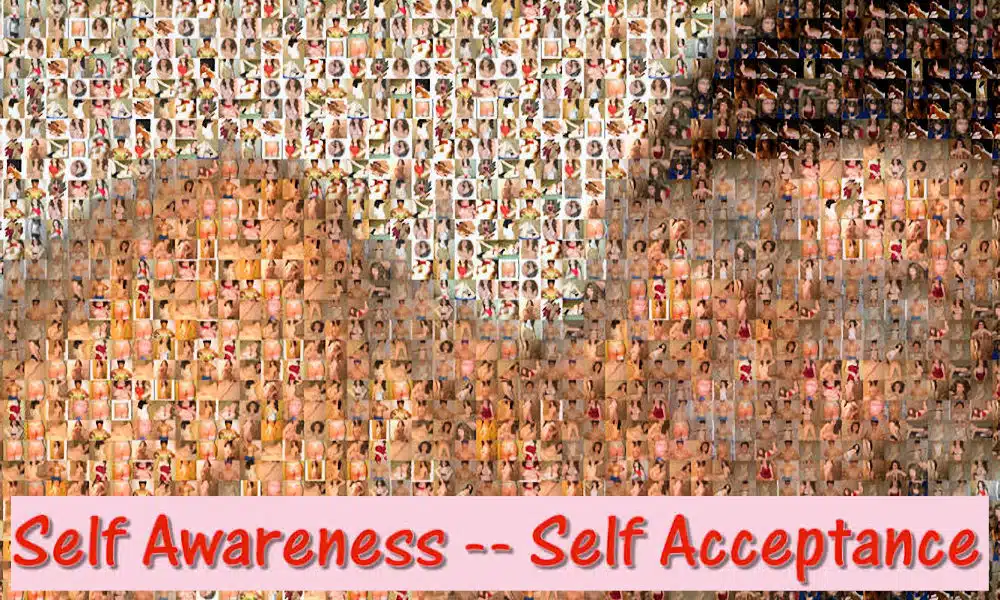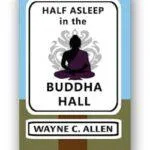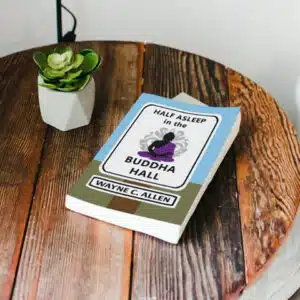Self Awareness / Self Acceptance is all about studying yourself without taking yourself too seriously. It’s not “esteeming yourself,” but simply noticing that you are… who you are.
Let’s have a look at the zone of self awareness

The 3rd Chakra is located at the solar plexus. Its zone runs from the belly button to the solar plexus, and on the back from an inch or so above the pelvis to the mid back.
The major organ contained in this zone is the stomach.
In this zone, it’s the stomach that most often gives us trouble.
For example, if you have to make a speech, and you’re not comfortable doing that, all of a sudden, you might notice that your stomach is queasy.
It’s not that you’re afraid of the audience—it’s not about something external. What’s going on here is that we are not comfortable in our own skins. In this case, we think that the audience is going to see right through us.
However, as usual, what happens for us is not about them. It’s about us.
In the book, “Anatomy of the Spirit,” Carolyn Myss describes this zone as the zone of self-esteem.
I’ve been thinking about that, and while I “get” the whole self esteem idea, this is one of those terms that can be badly misunderstood. Being the Zen guy that I am, I’d much rather head down the path of self awareness and self acceptance — that’s what this article is going to be about.
The problem with self-esteem
North Americans tend to equate self-esteem with pride, positive thinking, and eliminating everything that could be considered “bad.”
It’s almost as if people think that the goal of life is to repress the “bad list” while magnifying the “good list.” It’s like that song lyric,
“You’ve gotta accentuate the positive,
Eliminate the negative,
Latch on to the affirmative,
Don’t mess with Mister In-Between.”
Problem is, no one has ever pulled off this trick, and it’s a surefire recipe for misery. You see,
Mr. In-Between is actually right on track, at least from a Zen perspective.
The problem with all this positive thinking nonsense is that it simply doesn’t work. Here’s how it goes:
- you might get a moment’s peace, and start to believe that all that straining to be good is a great idea.
- And then life happens, and whatever normally goes on for you in reaction pops right back to the foreground.
- Then you flip to condemning yourself, blaming yourself, making life hard to stomach.
Ben Wong and Jock McKeen wrote that the ego (the home of self-esteem) has only two functions. The first is to say, “Try harder and you’ll be perfect.” Then, when you fail, (because perfection is impossible,) the ego says, “You are such an idiot. But if only you’d try harder, you could be perfect.” It’s an endless loop, and a no-win situation.
Carl Jung was an amazing psychotherapist, and was able to see the magic and mystery of life. He, I believe, was the first to coin the idea of The Shadow side of ourselves, which is like the “bag we drag.”

“bag you drag???”
He said something like this: around the time we get to be six months old, we end up with this little, tiny bag — it’s sort of the bag that society provides us with, so that we have a place to “stuff all the stuff” society tells us is unacceptable.
Parents endlessly modify the behavior of their children
—and do so verbally and nonverbally.
When you’re a kid, you don’t have much choice here
– parents are bigger and pretty much have their own way of making you behave. So, whole aspects of your personality, your skill set, and your emotional set gets stuffed into the bag.
Over the years, the bag gets bigger and bigger. By the time we head off to work, or go to university, the bag may be 20 or 30 feet long. We’re dragging it, and don’t know it.
All we know is that something doesn’t feel quite right, and it feels like the weight of the world is on our shoulders.
Thus, the 60s question, “What’s your bag, man?” Is actually a pretty good question.
Self acceptance, on the other hand, is all about the recognition that we are whole — the stuff in the bag is is much “us” as the stuff we show to the world.
I’m not suggesting that all the stuff in the bag is worthwhile — some of it should never see the light of day. It’s just that the bag that holds our stuff is sort of like any bag full of stuff.
We don’t have x‑ray vision, so the only way to know what’s in the bag is to empty it. Then, we can examine the stuff that we’ve stuffed, and make intelligent, adult decisions about what to keep and what to put back in the bag.
And here’s the kicker: the stuff we stuff back in the bag, having been evaluated in the light of day and by an adult, is still us!
Self acceptance means precisely what it says. I don’t get to cherry pick who I am. If I run around, pretending that life is sweetness and light, and that I’m the sugarplum fairy, I am definitely going to trip over over the stuff I’ve stuffed, and fall flat on my face. It’s just the way it is, and we hate it, because our sensitive little illusions are getting all bruised.
The stuff we stuff has a way of oozing out.
We want to deny it, claim someone made us do it, or otherwise escape responsibility, but as I said, the kicker is that the ooze is us, and we just haven’t accepted it.
Self acceptance matches the Buddha’s Middle Path.
One of the most important insights in Zen is that we have the choice to deal with our stuff, and with all of life, without judgment.
This doesn’t mean excusing bad behavior. It means that, when we engage in something that gets us lousy results, we see it, accept responsibility for doing it, fix what we can, and move on.

It’s sort of like sailing a sailboat into the wind. If you watch a sailboat sail, you realize it doesn’t progress along a straight line. If tacks. Heads off in a direction, makes a course correction, heads off in another direction, makes a course correction… on and on, forever.
We don’t judge that the boat is bad because of the back-and-forthness of its path.
Self acceptance works only when paired with a total self responsibility.
Back to the boat analogy. It would be the height of dumb to blame the wind for knocking the boat off course. Sailboats, like airplanes, are off course 95% of the time. Ultimately, tiny course corrections get them to safe harbor (or the airport…)
So there’s no blame involved, there’s just a simple acceptance that the way it is, is the way it is.
Judgment is never necessary.
Course correction is always necessary.
What a perfect definition of self responsibility
and self acceptance.
Here, in no particular order, are 6 ideas for deepening your self acceptance.
1. Make a list

You might be interested to know that my semi famous book “Living Life in Growing Orbits” is all about this work. The very first exercise in the book, which you can read about on the website, is to list what I call Rock Beliefs.
You write down what you believe to be so about how the world works, and about who you are.
Most of our beliefs about the world and about ourselves are in the form of couplets. This is good, that is bad. Happy is good, angry is bad. Controlled is good, emotional is bad. We just naturally assume that the things we believe are accurate.
Then, we get angry, and because we know anger is bad, we look around for someone or something to blame for our anger. As opposed to saying, “I am angering myself right now.”
The reason this happens is that we are conscious of our good list, and only semi-conscious of our bad list. Here’s a hint. The stuff you’ve stuffed is the stuff that seems to just pop up, out of your control, the stuff that you desperately want to deny has anything to do with you.
Make a list of this stuff. Visualize your bag, draped over your shoulder, set it down, open it up, and start to figure out what’s inside.
2. What do you want?
I have a really sweet, dear friend, who has an odd little statement on her Facebook page. It says,
“In order to know who you are,
you must know who you are not.”
I disagree. Making lists of what we do not want, or listing who we are not is a totally meaningless and endless task.
It’s like being asked, “What you want for Valentine’s Day?” and saying, “I don’t want chocolate.” (Man, what a bad example! Everyone wants chocolate!)
The problem with this approach is the person asking still has no clue what you do want.
In order to know who you are, you have to identify yourself: this is who I am, and this is what I want.
Make another list. This list contains all the things you want, all of your desires, all of those hot and chargy things you’ve always wanted to do. As you list them, you may notice your judgmental, egoic voice whispering or screaming, “Don’t go there!”
Have a breath, continue to make your list, and then prioritize the list. Then, and you knew this was coming, start doing things on the list.
3. Have your emotions
Emotions are important — all of them! But what will likely pop into your head is the good list / bad list concept. Some emotions are good, many of them are bad and never to be expressed.
Think about expressing anger. Most people stuff their anger. People are sick, people are sore, people are sad, and much of it has to do with repressed anger.
List time again. Go ahead, just this once. Make two columns, and title I Good Emotions, and the other Bad Emotions.
Go for it. Make your lists. Now, put a circle around the emotions you know you have, but seldom, or never express.
Construct a plan to begin having your emotions. While this might be difficult, let me remind you that “have your emotions” does not mean judge, then suppress your emotions. Have means have.
4. Belly rub time

are a circle…
Here’s the Bodywork part.
The belly area is full of trapped emotions. It’s also filled with your guts, ironically. You can’t be gutsy if you block yourself.
Now, this is not particularly an easy area to work with, because you can’t just push on it. So, for now, consider getting someone to simply make circles on your belly.
Have the person rub massage oil on your belly from below your ribs down to your navel. Then, have the person press downward, comfortably for you, and circle your belly in a clockwise direction. Or pick a spot in the middle of the upper belly, and then circle outward in a spiral, in a clockwise direction, until I reach the circle I defined above.
5. Push your limits

Every time.
Back to the list that you made in the second point. I suggested you start implementing some things on that list. Now, let’s push it a bit.
Most people imagine dire things as a result of asking for something. In fact, most people refuse to ask for anything they really want, or if they do ask they do it indirectly. “Boy, it would be really nice to get a massage someday.” Indirect.
This indirection, or not asking happens for two reasons.
- Many people have horrible, imaginary outcomes tripping around in their heads — they ask, and are totally rejected. Or, and this is actually the less common problem,
- they have asked in the past and were rejected.
Doesn’t matter. The time has come to explore who you are, what you want, and how you are going to live out your life, moment by moment, from this moment on.
Self responsibility means asking. If all you are hearing is “no,” you are definitely asking the wrong people. Maybe it’s time to hang around with a whole new crowd.
As I think about my relationship with Darbella, I recognize that “yes” happens about 95% of the time — perhaps higher. Why, oh why would I want to be in relationship with someone who only said “no?”
If this describes your relationship to your nearest and dearest, time to drop them off at the “Used People Lot.”
Then, look around. Find someone, or several someones, and ask for something that you’ve always wanted but have been afraid to ask for. Make this a day by day project for the rest of your life.
6. Be honest
I’m responsible for me! How exciting!
Self acceptance requires self responsible speech.
The only authentic pronoun is “I.” “I am making myself sad,” is true. The only one making you anything is you.
From this point on, own your emotions, your wants, your needs, your passions. Use “I” language with everyone you speak to. No blaming, no accusing, no looking to make trouble.
Be honest about who you are, what turns your crank, and what’s going on for you.



 Check out my book,
Check out my book,